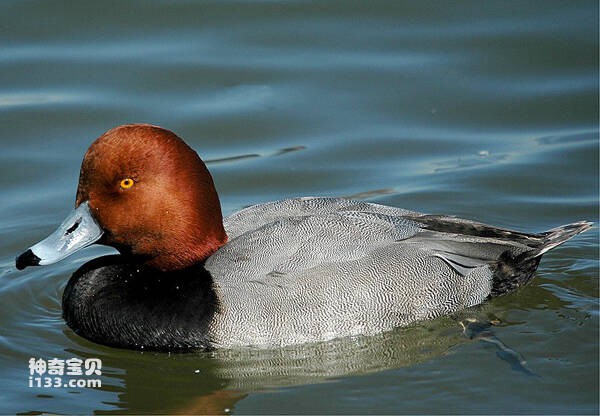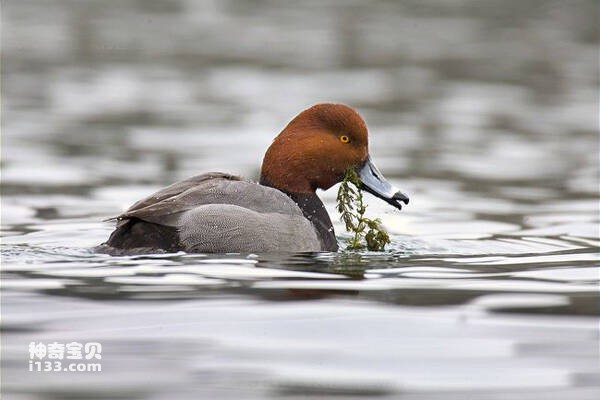Aythya americana
IUCN
LCBasic Information
Scientific classification
- name:Aythya americana
- Scientific Name:Aythya americana,Redhead
- Outline:Waterfowl
- Family:
Vital signs
- length:46-55cm
- Weight:680-1450g
- lifetime:No textual research information is available
Feature
The male duck has a coppery red head and neck, a blue bill, a black chest, orange-yellow eyes, and a gray back and side
Distribution and Habitat
It is found in the Bahamas, Bermuda, Canada, Cayman Islands, Cuba, Guatemala, Haiti, Mexico, Turks and Caicos Islands, and the United States.
Travellers: Barbados, Greenland, Guam, Jamaica, Japan, Saint Pierre and Miquelon, United Kingdom.
The American duck lives in the mountains, grasslands, great basins, and potholes. It can be found from sea level up to 2,000 meters in the mountains. The nest was built in high density near the marsh of the Great Salt Lake. Breeds in central and northwestern North America. Winter migration to the southern, central, and Central America of the United States, with southern Texas and Madrelli, Mexico, being important wintering grounds. During migration, a V-shaped flight is often formed.
Habitats include freshwater lakes, ponds and swamps. The water needs to be at least 70 cm deep for ducks to dive. Prairie pothole areas provide a perfect breeding area because potholes are filled with snow and rainwater melting water to provide temporary seasona
Appearance
The American diver weighs 680-1450 grams, is 46-55 cm long, and has a wingspan of 23 cm. It is smaller in size and darker in color in diving ducks. The male duck has a coppery red head and neck, a blue bill, a black chest, orange-yellow eyes, and a gray back and side. The abdomen is grayish white; The wings are gray with slight white spots; The claws are bluish-gray. When male ducks moult in June, the black becomes browner, while the red head is less colorful. By November, the dark winter plumage has grown.
The female duck has a mottled head and body, a dark blue bill, and a black top. Adult males are easily confused with the sail-back diver, distinguished by the steep forehead, grey back, and blue beak of the American diver. The female duck is not as brightly colored as the male, with a tawny head and somewhat dark crown, a slight pale ring around the brown eyes, a mostly dark grayish-brown body and tail, and a white belly that fades to grayish-brown. The wings are brown and gray.
Details
American submerged duck (Aythya americana) Redhead, no subspecies.

The American duck is a migratory bird. They migrate in groups, usually in small groups of 5-15 individuals. But in winter, they can gather in the thousands. The breeding range extends from southern Canada to the northern United States (Washington to Maine). Many American ducks breed in the prairie potholes of the northern Great Plains. There are also some breeding populations in central Alaska. In September, the ducks migrate through northern and central Mexico for the winter and from California to the Gulf and Atlantic coasts. Most wintered in Florida and Mexico.
The American diver's foraging activities are mainly in the early morning and dusk, and during the day they mostly rest on the shore or float on the open water to sleep. Foraging methods mainly rely on diving to feed, generally in the water is not too deep, and sometimes in the shallow water at the water's edge to extend the head into the water, or tail up into the water to feed.

The American diver's diet consists mainly of plant matter. They dive to the bottom of bodies of water to feed on aquatic plants and mollusks, and wade on the surface of shallow swamps to locate insects. Before the spawning season, the intake of female animals will increase the protein content. At this time, about 77% of the diet is animal-related. About half of the duckling's diet consists of animal matter to provide the nutrients needed for growth. Common foods include: grass, pond grass, thyme, sedge, grass, wild celery, duckweed, water lilies, grasshoppers, goji berries, water fleas and snails.
People found in the study of the American submerged duck: although the American submerged duck nesting and breeding, but also often lay eggs in the nests of other ducks, so that they can incubate eggs, this phenomenon is called incomplete nest parasitism behavior. The female American diver always has the idea of sailing back to the nest. But the eggs of the sail-back diver are pale green, while the eggs of the American diver are white. The female American diver lays her eggs in the middle of a nest of sail-back diver eggs in an attempt to blend with the fish. The female sail-back diver has left the nest to find food, and there is a white egg in the nest, which means that more than one American diver has used the nest to lay eggs. The pair of American ducks are off to build their own nest. By doing so they had bought insurance, for danger lurked everywhere in the Lake District. They must do it as safely as possible to ensure that the family will continue.
Listed in the International Union for Conservation of Nature Red List of Threatened Species (IUCN) for 2016 ver 3.1 - Not Threatened (LC).
Protect wild animals and eliminate wild meat.
Maintaining ecological balance is everyone's responsibility!








